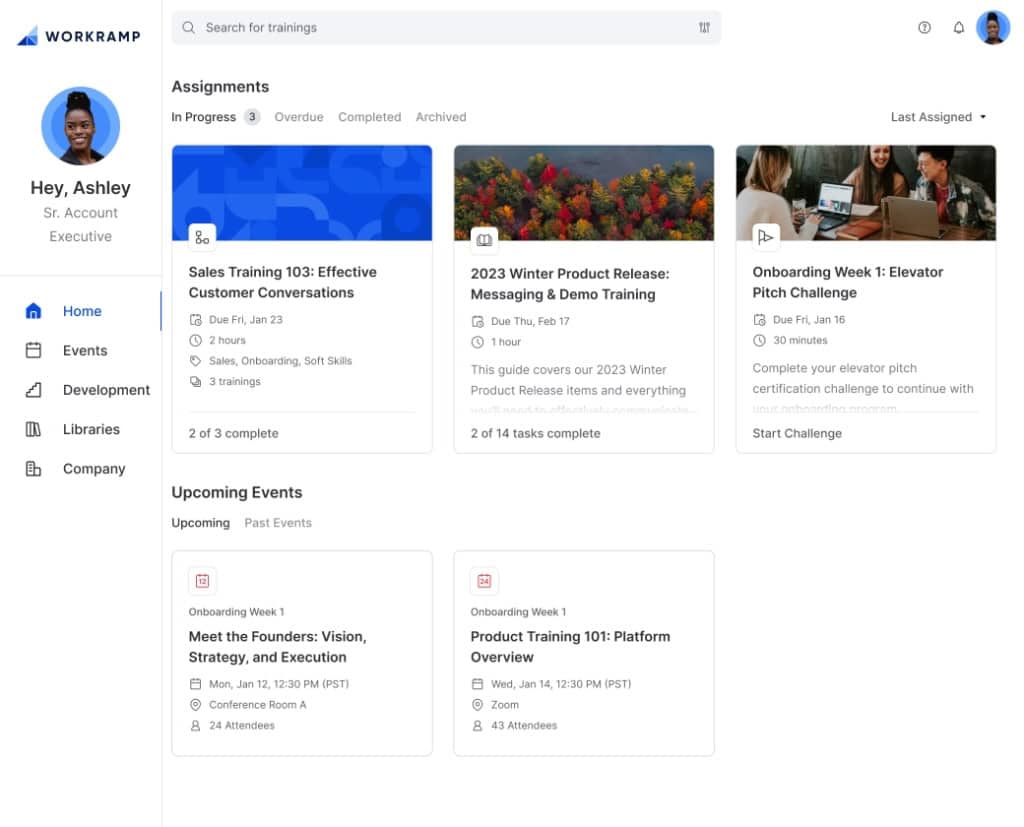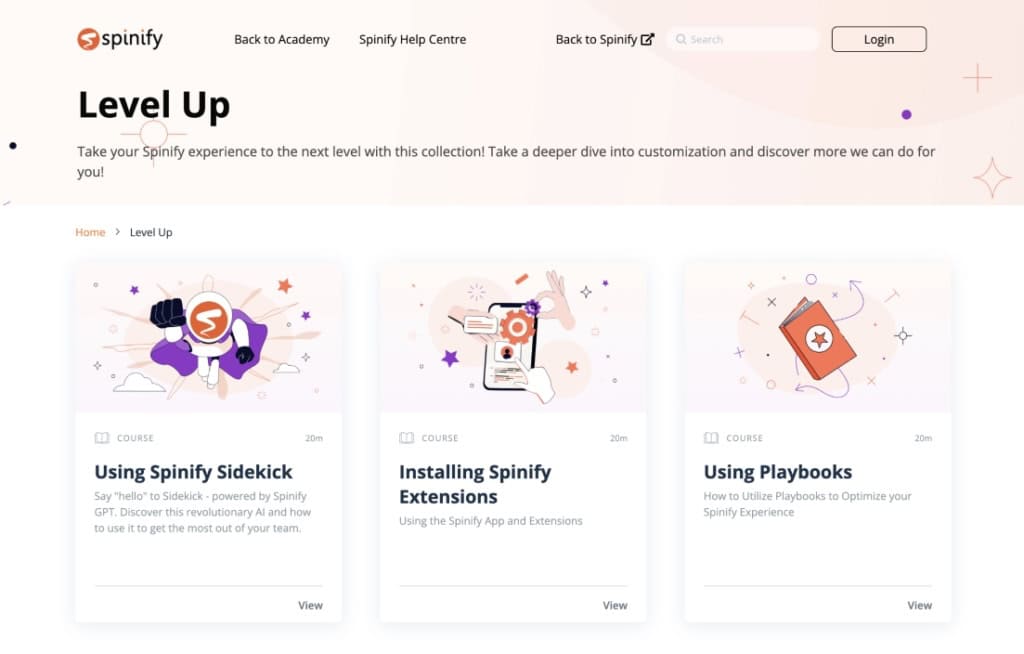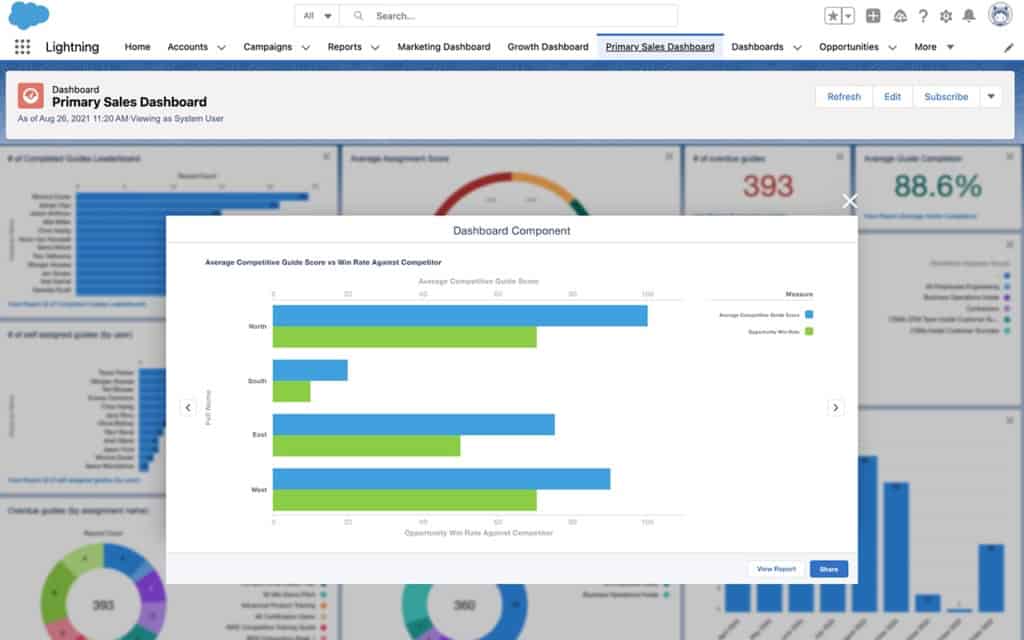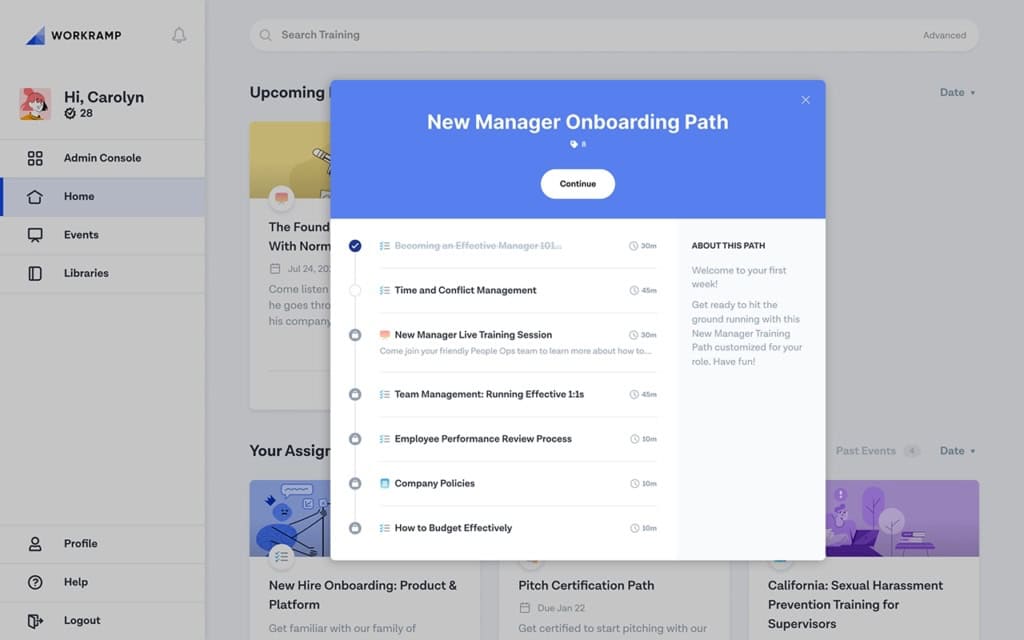11+ Sales Enablement Best Practices to Implement in 2024
Michael Keenan | WorkRamp Contributor
View bioLearning Tips Straight to Your Inbox
It was just another manic Monday and your boss asked for last month’s quotas.
Inhale, exhale.
You’re trying to find a way to tell them that you missed the mark. Customers have become more demanding, and your team may not have the tools and resources to sell.
This is where effective sales enablement comes in.
By consistently training reps, you empower them with the knowledge they need at every stage of the sales process.
Adopt these sales enablement best practices to ensure your team’s success and hit new heights in your performance.
In this post:
What is sales enablement?
Sales enablement is the training you offer sales reps. It’s an ongoing effort that gives sellers the knowledge, skills, and content they need to engage buyers.
The goal of sales enablement is two-sided:
- To ensure reps are well-equipped to meet buyers’ needs by providing contextual guidance
- To give buyers the most relevant resources to speed up the sales cycle
Sales enablement has become a major force for organizations in the last decade because it can improve sales productivity and performance.
Reports show that 90 percent of surveyed organizations have one dedicated person, program, or function for sales enablement as of 2023.
Sales enablement best practices to know
Whether you’re running your first or 15th sales team, keep the following best practices in mind.
1. Use the right sales enablement technologies
Being a great sales enablement manager goes far beyond creating processes. You have to give your team the right tools to stay competitive.
Tools like CRM, sales content management, email automation, and Learning Management System (LMS) can help teams sell better and increase conversions.
For example, with a sales training LMS like the Learning Cloud from WorkRamp, you can create self-paced learning programs that give reps the knowledge and skills they need to achieve outstanding business outcomes.
Our data shows that:
- 84% of sales reps meet their quotas when an employer incorporates enablement training
- 57% of organizations that invest in sales training are more effective than competitors
- Sales training leads to a 353% increase for the average company
Reddit’s Principal Program Manager Ashley Crisostomo has successfully used WorkRamp for Sales Enablement, reducing new hire ramp-up time by 33 percent and increasing internal NPS by 13 points. Reddit uses WorkRamp to streamline L&D, train GTM teams, roll out brand initiatives, and have high employee engagement and satisfaction in training.
2. Align your sales & marketing teams
When sales and marketing are aligned, they can work together towards common goals more effectively. Sales teams are on the front lines with customers and have valuable insights to share. They can share these insights with marketing to help generate higher-quality leads more likely to convert.
Say you’re a technology company that sells a complex software solution. The marketing team is hard at work developing detailed guides and webinars to attract users. Meanwhile, sales is constantly giving feedback on the most common questions and hurdles faced during sales conversations.
The marketing team can implement these insights into its messaging. They can also use it to create sales enablement content for reps to use during pitches. This synergy between sales and marketing improves efficiency and the overall customer experience.
3. Provide proper training & upskilling
Being in sales is challenging. Reps need to understand exactly what they are selling and have the soft skills to make sales happen. Buyers have more access to information than ever, so you must gain their trust by being authentic.
Authenticity and empathy are even more essential as teams leverage new tools and technologies.
“As a sales professional, being able to be in the shoes of your prospect or customer is invaluable,” Marit Parten, Head of Revenue Productivity, Sales Enablement, Narvar says. “AI will change things, but let’s just keep empathetic and real and see what [our customers’] needs are. It’s absolutely invaluable to follow that customer journey and identify where we can truly help.”
LinkedIn recently found that upskilling employees is the second top focus area for L&D professionals. As a manager, your reps need regular training to keep up with industry trends, new products, and competitive info. This helps them remain relevant and effective.

To ensure your team is also equipped with the latest knowledge, you can:
- Set up a continuous learning program that covers new product features and market trends
- Give reps access to an online learning portal with microlearning modules.
- Create a hub with templates and extra tools for sales success
- Conduct workshops on advanced sales techniques
Sales is a skill-based profession; like any skill, it can be honed and improved. A comprehensive training and upskilling strategy keeps teams proficient and helps your organization maintain a competitive edge in the market.
4. Make it easy to access sales content
Good salespeople are resourceful. When they can easily access the content they need, they can spend more time selling and less on administrative tasks. Easy access to sales materials (think presentations, product sheets, and case studies) guarantees that sales teams use consistent and accurate information in customer interactions.
With a digital library, reps can quickly respond to customer queries and tailor materials to each account. Digital analytics software brand Quantum Metric loved having “one product content library, a single source of truth, for all things Quantum Metric,” Director of Enablement Chauncy Cay Ford explains.
With WorkRamp, Chauncy and her team compiled all learning information for internal and external stakeholders into one place. It allowed teams to share resources and establish an understanding of the product across the organization, from sales to customer enablement.
5. Personalize content for different customers
Customers who feel that a pitch or presentation is tailored to their needs are more likely to pay attention and consider your offer. Personalizing content shows customers you understand their problems and can build trust throughout the relationship.
Personalized sales content can help a potential customer see your product or service as a tailored solution for their specific needs and pain points. Demonstrating the use cases most applicable to their needs gives them a clear picture of how using your product can benefit them.
When prospects feel that the information presented aligns with their needs and objectives, they are more likely to retain and recall the details of the interaction. This retention not only bolsters the chances of conversion but also contributes to the longevity of the customer relationship.
With a customer training LMS, you can build learning content, events, and resources for each customer. You can create different training modules based on customer profiles, helping customers grow product knowledge and giving administrators the authoring tools they need to manage programs easily.

When Tony Vaughn, the director of Qualified University, needed an all-in-one learning platform for customers and sales enablement, he turned to WorkRamp. “The most critical thing for us was ensuring our system would drive a connected experience,” Tony said.
“WorkRamp allowed me to understand what customers were being trained and pass them to our success team, capture prospects exploring our customer education content and pass them to our sales team, and then report on all of it in Salesforce, without needing to pay for professional services.”
Tony’s team built out content for each customer persona at scale. By using the WorkRamp content library, they were able to improve product training and improve ramp time.
6. Identify & analyze high performers
High performers in sales often have a set of behaviors and strategies that contribute to their success, whether they know it or not. When you identify these elements, you can understand what drives top performance. Maybe it’s communication skills, advanced product knowledge, or exceptional customer handling skills—you won’t know until you explore it.
The insights you gain from these high performers can improve your learning and development program. For example, if top performers excel in closing deals or generating repeat business, you can emphasize these skills in training sessions for the entire team.
Say you want to see the relationship between a rep’s sales and their training. If you’re using WorkRamp’s Salesforce integration, you can monitor how training completion correlates with sales metrics like conversion rates or average deal size improvements.

You can create custom learning paths in WorkRamp based on roles or performance metrics tracked in Salesforce. If a rep struggles to close deals, you can automatically enroll in training to help them improve.
7. Analyze the impact of content
Learning analytics tools can monitor how different sales materials are used and their effectiveness. You can find which case studies, brochures, and product demos are most popular amongst reps and correlate them with sales outcomes.
For example, you might analyze how often a particular case study is used in sales pitches, then compare this data with close rates where it was used. Over time, you can discover patterns in your best-performing assets and see which types of content work best at different stages of the sales cycle or which materials are more effective with certain customer segments.
8. Create individual coaching plans
Training is the backbone of a successful program, from the first days of sales onboarding to internal promotions. It’s an ongoing process that involves understanding where individual reps need improvement and where they can develop their strengths.
A sales coaching plan usually includes training sessions, one-on-one meetings, and practical exercises. A sales rep working on negotiation skills could involve role-playing exercises, attending workshops, or shadowing more experienced colleagues during negotiations.
With the Learning Cloud, you can create customized learning paths with lessons and resources specific to their needs. After every course, you can also place custom quizzes to see if reps understand the lessons.
Reps can track their progress and stay motivated throughout their learning journey.

9. Automate when possible
Organizations use automation to make processes more consistent, identify promising leads, and personalize customer communications. It also handles tedious (and boring) tasks like data entry and follow-up emails.
But at the end of the day, automation helps you scale with less headcount. For example, you can automate the training process for sales hires or organize and distribute sales materials in seconds. While AI can’t replace a human training facilitator, it can help glean insights into your sales programs and streamline workflows to make teams more productive.
10. Make collaboration simple
Collaboration improves the way your sales team works together and solves problems. Make it easy for them to communicate with each other and different departments. Use a platform like Slack to allow for instant messaging. For example, you can send reminders throughout training programs to ensure reps complete their lessons.
As noted, a centralized hub for all sales-related materials, like customer data, pricing guides, and product sheets, is key to collaboration. With a custom internal database through the Learning Cloud, everyone can access the latest materials and data.
11. Involve stakeholders
Don’t go about setting up an enablement function alone. Stakeholders like your product team and customer service reps can provide insight into your product or service.
Product, for example, can provide deep technical knowledge and updates about features, benefits, and upcoming improvements. Customer service, on the other hand, offers valuable feedback on the product straight from the customer’s experience.
With direct input from those who design and support the product, reps can tailor their sales approach to customers’ needs. It’ll make customers happier and more trusting if they get accurate and relevant solutions.
Break down those silos. Work to build a cohesive, collaborative ecosystem with stakeholders that improves every aspect of the sales cycle.
Start implementing your sales enablement best practices
Sales enablement is your safeguard against poor sales performance. Numbers will dip, but solid enablement practices can ensure your organization won’t become a relic of the past.
Train your sales reps with excitement, engagement, and enthusiasm so that they can be successful in the future.
With the right tools and resources, great sales enablement teams can be even more effective. With the Learning Cloud, you can train your sales team on demand, increase revenue, and close deals more effectively by increasing rep efficiency, driving revenue, and improving performance.
Contact us for a free, personalized demo to learn more about the Learning Cloud can help your reps perform their best.
Complete the form for a custom demo.
Recent Posts
- Top LMS Integrations That Power Smarter, Faster Learning July 2, 2025
- Introducing WorkRamp Analytics Studio: Unlocking Your Data Insights with AI June 30, 2025
- 11 AI LMS for AI-Powered Learning June 27, 2025
- The Best LMS Platforms for Customer Retention (2025 Guide) June 27, 2025
- 11 Best AI Learning Platforms June 16, 2025
Michael Keenan
WorkRamp ContributorMichael is a SaaS marketer living in Guadalajara, Mexico. Through storytelling and data-driven content, his focus is providing valuable insight and advice on issues that prospects and customers care most about. He’s inspired by learning people’s stories, climbing mountains, and traveling with his partner and Xoloitzcuintles.
You might also like
3 essential sales enablement tools
Too many tools can be distracting for reps. Here are the enablement tools you really need to achieve sales goals.
Read More
Empower your sales team and maximize your revenue
Having practical, actionable strategies can help you improve sales quickly–and if implemented right away, you may see the difference this year.
Read More
Why you need sales enablement content as part of your sales strategy
The right sales enablement content empowers your team to answer questions, address objections, concerns, and pain points, and convert prospects into customers.
Read More
Ready to Explore Online Learning Platforms?
Get in touch to learn how WorkRamp can help you achieve your training goals.
Request a Demo




